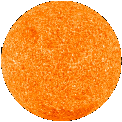|
We start our tour with the Sun, an enormous ball of hot gas which completely dominates the solar system. In fact the planets are really just tiny pieces of cosmic debris, material that wasn't swallowed up by our star when it formed from a disc of dust and gas billions of years ago. |

|
The small dot between the title and this paragraph represents the planet Mercury in this scale model. A world in its own right, with a diameter of almost 5000 kilometres, it shows up merely as a tiny speck compared to the vastness of space. |
|
Venus is our nearest neighbour in the solar system, and is clearly visible in the night's sky just after dawn or in the early evening. It shines so brightly not only because of its proximity to us but also because it's pale yellow clouds reflect a lot sunlight. |
|
Everyone and everything you have ever known exists on this single "Pale blue dot". 6 billion people plus countless of species of animals and plants - all crammed onto this little rock in space. There's nothing else quite like it in the solar system, we really ought to be taking care of it. |
|
Take a look at your scroll bar. The first four planets all orbit relatively close to the Sun. They are also fairly small and consist mainly of rock with a wispy, thin atmosphere. These are called the terrestrial planets. After Mars, the space between the planets switches to a whole new scale. |
|
Notice the difference? The outer planets, called the gas giants are (with the exception of Pluto) much bigger than the planets of the inner solar system. They consist mainly of hydrogen and helium and typically have large numbers of moons orbiting around them. They are also spread much further apart. These differences are an important clue in explaining how our solar system formed. |
|
Another feature common to the outer planets is the existance of rings around them. Although Saturn's rings are by far the most obvious and spectacular, Jupiter, Neptune and Uranus all have small, tenuous ring systems. |
|
When William Herschel discovered the planet Uranus in 1781 he effectively doubled the size of the known solar system. Uranus is around the same distance from Saturn as Saturn is from the Sun. |
|
Out at these distances, the Sun appears to be little more than a bright star. It is a considerable feat for astronomers on Earth to view the outer planets because they give off so little reflected light. All the fantastic images we have of the outer planets were taken by the Voyager probes. |
|
For the purpose of this model I have used the average distance of Pluto from the Sun. In fact Pluto's orbit is highly elliptical and varies so much that for some of the time it is actually closer to the Sun than Neptune. |

